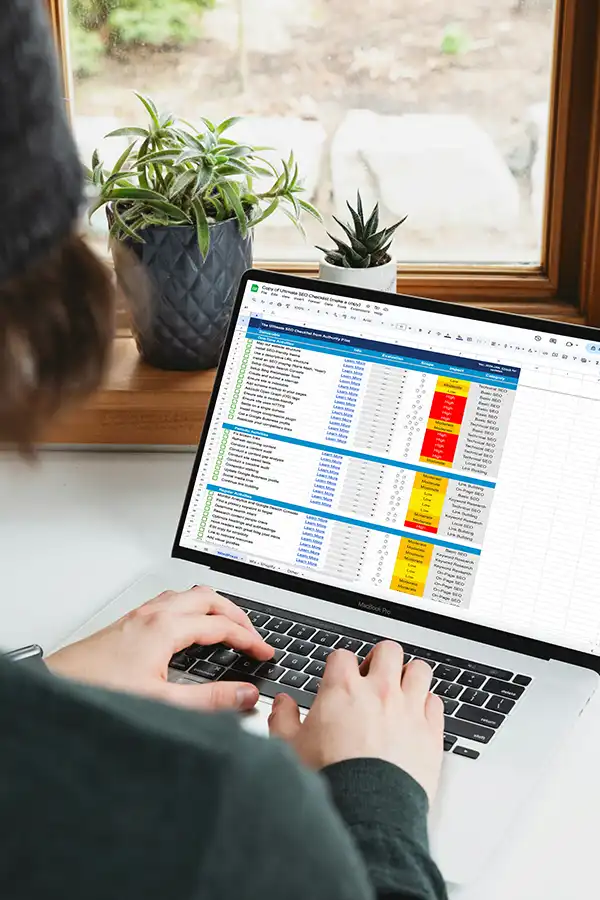
Making your website welcoming and easy to use is crucial. Core Web Vitals are key metrics by Google that help measure how friendly your site is to visitors. Improving these can boost your site’s SEO, attracting more visitors and keeping them happy. As Google increasingly prioritizes user experience in its ranking algorithm, optimizing these vitals becomes imperative for any SEO strategy.
What are Core Web Vitals
Core Web Vitals are a set of specific factors that Google considers important in a webpage’s overall user experience. These vitals are part of Google’s Page Experience signals used to gauge the quality of a user’s experience.
The components of Core Web Vitals include:
- Largest Contentful Paint (LCP): Measures loading performance. To provide a good user experience, LCP should occur within 2.5 seconds of when the page first starts loading. Speeding up server responses and optimizing images can improve LCP.
- First Input Delay (FID): Measures interactivity. For a good user experience, pages should have an FID of 100 milliseconds or less. Reducing or deferring JavaScript can enhance this metric.
- Cumulative Layout Shift (CLS): Measures visual stability. Pages should maintain a CLS of 0.1. or less. Assigning size attributes to media and ensuring ads have a designated space can help stabilize layout.
The Impact of Core Web Vitals on SEO
Google is continuously refining its algorithms to favor websites that offer superior user experiences. The introduction of Core Web Vitals into the SEO equation marks a significant shift towards prioritizing the performance and usability of websites. This focus underscores the importance of not just attracting visitors but ensuring their online journey is smooth, engaging, and satisfactory.
Google’s Emphasis on User Experience
Google has long championed user experience (UX), advocating for websites that are not only informative but also accessible and enjoyable to use. The integration of Core Web Vitals into Google’s ranking criteria is a testament to this commitment. Websites that excel in these metrics are likely to enjoy better rankings, as they align with Google’s goal of providing users with search results that meet their needs in the most efficient and satisfying manner possible.
Core Web Vitals as Ranking Signals
Core Web Vitals serve as a concrete set of criteria that Google uses to assess a website’s user experience quality. These metrics — Largest Contentful Paint (LCP), First Input Delay (FID), and Cumulative Layout Shift (CLS) — directly influence a website’s search engine rankings. A website that loads quickly, responds promptly to user inputs, and maintains visual stability throughout the browsing experience is more likely to rank higher in search results. This elevation is not merely about technical superiority; it’s about offering a user-centric web experience that Google values.
Diagnosing Core Web Vitals Issues
Website optimization begins with identifying the areas for improvement. Core Web Vitals issues, reflecting key aspects of user experience, require precise diagnosis to effectively enhance your site’s performance and SEO ranking. Fortunately, a suite of tools developed by Google provides comprehensive insights into these vital metrics, guiding webmasters and developers through the optimization process with clarity and precision.
Google PageSpeed Insights
Google PageSpeed Insights is a powerful tool that analyzes the content of a web page, then generates suggestions to make that page faster. By entering a URL, you receive a detailed report highlighting both the performance of a page on mobile and desktop devices. This tool focuses on various metrics, including Core Web Vitals, offering clear insights into how well your site performs in terms of loading speed, interactivity, and visual stability. The recommendations provided can guide your optimization strategies, pinpointing specific areas where improvements can have a significant impact.
Lighthouse
Lighthouse is an open-source, automated tool designed to improve the quality of web pages. It can be run directly in the Chrome browser or as part of your development workflow. Lighthouse audits five areas: performance, accessibility, progressive web apps, SEO, and Core Web Vitals. For each audit, it not only scores your page but also offers a list of actionable recommendations. This tool is particularly useful for developers seeking to integrate performance optimization into their development process, ensuring that Core Web Vitals are considered from the ground up.
Chrome User Experience Report
The Chrome User Experience Report offers a user-centered perspective on performance metrics. Unlike the other tools, this report uses real-world data from Chrome users to show how your site performs across various conditions. It’s invaluable for understanding the actual user experience, guiding targeted optimizations that matter most to your audience.
Strategies to Optimize Core Web Vitals
Optimizing Core Web Vitals is pivotal for any website aiming to enhance user experience and boost SEO rankings. A focus on improving Largest Contentful Paint (LCP), First Input Delay (FID), and Cumulative Layout Shift (CLS) can significantly impact how users perceive and interact with your site. Here are targeted strategies to address each of these critical metrics effectively.
Optimizing Largest Contentful Paint (LCP)
Improving LCP focuses on the speed at which the main content of a webpage becomes visible to users. Two key areas to address are server response times and the optimization of images and media:
- Improving Server Response Times. A fast server response is crucial for quick content rendering. Consider upgrading your web hosting solution, utilizing a Content Delivery Network (CDN) to reduce latency, and optimizing server-side rendering. Efficient caching strategies can also significantly reduce load times for repeat visitors.
- Optimizing Images and Media. Large images and media files are often the culprits of slow LCP times. Compressing images, using next-gen formats like WebP, and implementing lazy loading can drastically reduce the bandwidth needed and speed up loading times. Ensure videos are optimized and consider their impact on LCP when placed above the fold.
Enhancing First Input Delay (FID)
FID measures the time from when a user first interacts with your site to the moment the browser is able to respond. Minimizing JavaScript execution is key to improving FID. JavaScript can block the main thread, delaying the browser’s response to user inputs. Break up long tasks into smaller, asynchronous tasks to reduce delay. Remove any non-essential third-party scripts and minimize the use of JavaScript for critical interactions wherever possible.
Reducing Cumulative Layout Shift (CLS)
CLS measures the stability of your website as it loads, ensuring that users don’t experience unexpected shifts in page layout. Two strategies to combat high CLS scores include specifying image dimensions and avoiding intrusive ads and pop-ups:
- Specifying Image Dimensions: Set explicit width and height attributes for images and video elements to allocate the correct amount of space in the document layout before they load. This prevents layout shifts as these elements load into view.
- Avoiding Intrusive Ads and Pop-ups: Ads and dynamically loaded content can cause significant layout shifts if not properly managed. Ensure ads have a reserved space and avoid placing new content above existing content. Pop-ups should be used sparingly and designed in a way that doesn’t disrupt the layout.
Implementing the Improvements
After pinpointing how to boost Core Web Vitals, it’s time to put your plans in motion. This involves enhancing the mobile experience, continuously monitoring performance, and using technologies like CDNs and browser caching for optimal results.
Prioritizing Mobile Experience
With mobile browsing at the forefront of internet usage, optimizing for mobile is essential. Ensure your site is responsive and loads quickly on mobile devices to meet user expectations and improve Core Web Vitals scores, considering mobile-first strategies like AMP for faster, more efficient delivery.
Regular Monitoring and Adjustments
The digital world is always changing, and so are user habits. Use tools like Google’s PageSpeed Insights and Lighthouse to keep tabs on your website’s performance. Regular checks help identify issues and adjust strategies, keeping your site optimized for both users and search engines.
Utilizing CDN and Browser Caching
Deploying a Content Delivery Network (CDN) can significantly speed up load times by serving your site’s content from servers close to the user, improving LCP. Browser caching makes subsequent visits faster by storing site data locally, enhancing overall user experience and Core Web Vitals.
The Role of Professional SEO Services
Navigating SEO to boost your website’s performance can be daunting. Professional SEO services, like those offered by Authority Pilot, provide the expertise and support needed to make this process smoother and more effective.
Authority Pilot offers tailored SEO solutions, including SEO optimization, PPC, link building, and content creation. Their approach focuses on improving Core Web Vitals and overall SEO, using data-driven strategies to tackle specific challenges your website faces, enhancing its performance and user experience.
The Benefits of On-demand SEO Services
- Expert Guidance. Benefit from the knowledge of seasoned SEO professionals.
- Custom Strategies. Get SEO plans designed to meet your website’s unique needs.
- Efficiency. Save time and resources, allowing you to focus on your business.
- Scalability. Easily adjust your SEO efforts as your business grows.
- Clear Insights. Receive detailed reports on how SEO improvements are boosting your site.
Conclusion
Optimizing Core Web Vitals is not just about appeasing search engines; it’s about providing your users with the best possible experience. By focusing on these vital metrics, you can ensure your site not only ranks better but also delivers value to your visitors, ultimately leading to higher engagement and conversion rates.















